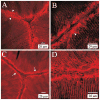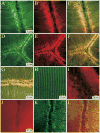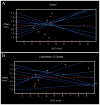A novel terminal web-like structure in cortical lens fibers: architecture and functional assessment
- PMID: 20730867
- PMCID: PMC2967581
- DOI: 10.1002/ar.21216
A novel terminal web-like structure in cortical lens fibers: architecture and functional assessment
Abstract
This study describes a novel cytoskeletal array in fiber cells of the ocular lens of the rat and shows its relationship to the classical terminal web of other epithelial tissues. Naive adult Sprague-Dawley rats (n = 28) were utilized. F-actin, fodrin, myosin IIA, and CP49 distribution was assessed in anterior and posterior polar sections. For functional analysis, lenses were cultured with or without cytochalasin-D for 3 hr, then processed for confocal microscopy or assessed by laser scan analysis along sutures. Phalloidin labeling demonstrated a dense mesh of F-actin adjacent to posterior sutural domains to a subcapsular depth of 400 μm. Anterior polar sections revealed a comparable actin structure adjacent to anterior suture branches however, it was not developed in superficial fibers. Fodrin and myosin were localized within the web-like actin apparatus. The data was used to construct a model showing that the cytoskeletal array is located within the blunt, variable-width fiber ends that abut at sutures such that the "terminal web" flanks the suture on either side. Treatment with cytochalasin-D resulted in partial disassembly of the "terminal web" and perturbed cellular organization. Laser scan analysis revealed that cytochalasin-D treated lenses had significantly greater focal variability than control lenses (P = 0.020). We conclude that cortical fibers of rat lenses contain a bipolar structure that is structurally and compositionally analogous to classical terminal webs. The results indicate that the lens "terminal web" functions to stabilize lens fiber ends at sutures thus minimizing structural disorder, which in turn, promotes the establishment and maintenance of lens transparency.
Figures







References
-
- Al Awqati Q, Vijayakumar S, Takito J, Hikita C, Yan L, Wiederholt T. Terminal differentiation in epithelia: the Hensin pathway in intercalated cells. Semin Nephrol. 1999;19:415–420. - PubMed
-
- Al Awqati Q, Vijayakumar S, Takito J, Hikita C, Yan L, Wiederholt T. Phenotypic plasticity and terminal differentiation of the intercalated cell: the hensin pathway. Exp Nephrol. 2000;8:66–71. - PubMed
-
- Al-Ghoul KJ, Kuszak JR, Lu JY, Owens MJ. Morphology and organization of posterior fiber ends during migration. Mol Vis. 2003;9:119–128. - PubMed
-
- Al-Ghoul KJ, Novak LA, Kuszak JR. The structure of posterior subcapsular cataracts (PSCs) in the Royal College of Surgeons (RCS) rats. Exper Eye Res. 1998;67:163–177. - PubMed
-
- Alberts B, Johnson A, Lewis J, Raff MC, Roberts K, Walter P. Molecular biology of the cell. 4. New York: Garland Science; 2002.
Publication types
MeSH terms
Substances
Grants and funding
LinkOut - more resources
Full Text Sources

